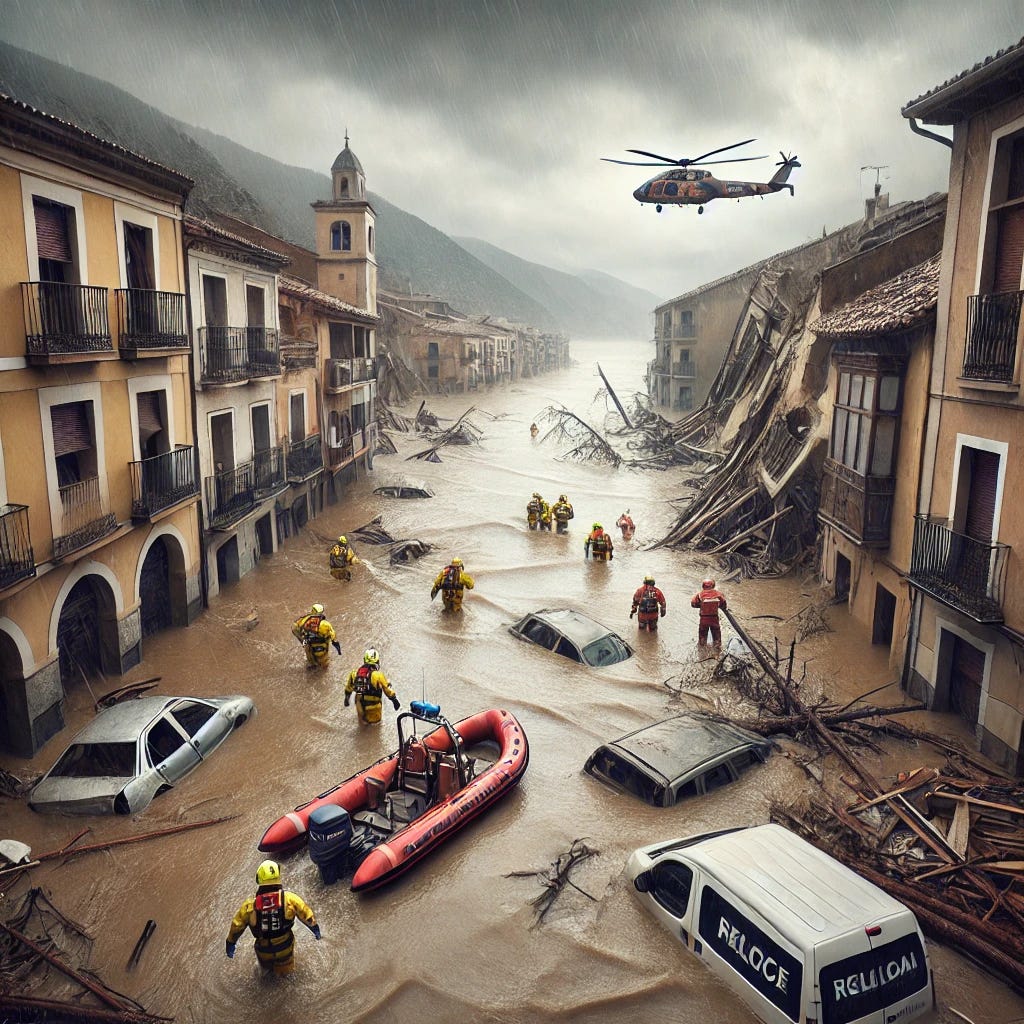At Least 95 Feared Dead in Spain’s Catastrophic Floods: Rescue Efforts Intensify Amid Widespread Devastation
As catastrophic floods claim at least 95 lives around Valencia's Mediterranean coastline, Spain faces rising scrutiny over its climate change preparedness and disaster response.
1. A Nation in Mourning: The Human Toll of Spain’s Worst Flooding Event
On Thursday morning (October 31), Spaniards awoke to a scene of unimaginable devastation in the wake of one of the deadliest natural disasters in the country's recent history. Flash floods, triggered by an unprecedented downpour, claimed at least 95 lives, with the toll expected to rise as rescue workers continue their search. Spanish Transport Minister Óscar Puente confirmed that many victims were trapped in their vehicles as they were overtaken by the deluge. Prime Minister Pedro Sánchez declared three days of mourning, stating that the government’s priority was to support grieving families and find the missing.
2. The Force of Nature: Unprecedented Flooding and its Impact on the Region
The Mediterranean coastline, particularly around Valencia, bore the brunt of the floods, with powerful torrents converting narrow village streets into treacherous rivers. Cars piled on top of each other, uprooted trees littered the roads, and homes were reduced to rubble. Infrastructure, including bridges and roads, was severely damaged, effectively isolating parts of the affected region and impeding rescue operations. The floodwaters even reached Andalusia, where heavy rains and a freak tornado compounded the destruction.
3. The Climatic Link: How Climate Change Fuels Extreme Weather Events
This catastrophic event has once again highlighted the impact of climate change on weather patterns. Spain’s Mediterranean coast is familiar with autumn storms, but scientists point to rising global temperatures and a warming Mediterranean Sea as contributing factors to this year’s deadly rains. Unseasonably high temperatures and drought conditions have increased the volatility of Spain’s climate, making extreme weather events more likely and potentially more deadly.
4. Rescue Efforts Amidst Chaos: The Challenge of Saving Lives
Over a thousand soldiers from Spain’s emergency units joined local emergency responders in the effort to save lives and recover the deceased. Helicopters rescued 70 people from rooftops, while ground teams combed through debris-laden streets and damaged buildings in their search for survivors. More than 22 bodies have been recovered, and 110 individuals have been rescued. Despite the progress, the region remains partially inaccessible, complicating the rescue and recovery operations.
5. Lack of Warning: Regional Officials Face Criticism Over Response
As floodwaters ravaged communities, questions arose regarding the adequacy of the government’s response. Many local residents criticised the lack of timely flood alerts, with some notifications arriving only after streets were already inundated. In areas like L’Alcudia, residents and even local officials were caught off-guard as rivers burst their banks, turning calm neighbourhoods into disaster zones. Valencian regional President Carlos Mazón defended the response, stating that protocols were followed, but a closer look is likely to follow.
6. Infrastructure and Resource Strain: Rebuilding and the Path Forward
The floods also left hundreds of thousands without basic services like electricity and drinking water. Power outages affected around 150,000 people in Valencia alone, though half of these were resolved by Thursday. Access to clean water remains scarce, prompting residents to buy up bottled water. Road closures and rail disruptions have isolated many communities, and authorities warn it could be days before transportation is fully restored.
7. A Country on Alert: Storms and Flood Warnings Continue
Even as Spain reels from the initial impact, the Spanish meteorological agency issued further warnings for regions north of Valencia, including red alerts for Castellón and parts of Tarragona. Residents are advised to stay indoors as heavy rains continue to pose a danger to those in affected areas. Authorities are calling for a reassessment of Spain's climate preparedness, as extreme weather patterns become increasingly frequent across the Iberian Peninsula.
Summing Up
Spain’s recent flash floods stand as a stark reminder of the destructive potential of climate-related disasters and the humbling reality of human vulnerability before nature’s wrath. While communities in Spain are grappling with a rising death toll—now approaching 100—and the monumental task of rebuilding, this tragedy resonates globally. In the past months, the Gulf Coast of the United States has also seen the lethal power of extreme weather, where hurricanes claimed numerous lives despite early warnings and robust forecasting. In Texas, Louisiana, and Florida alone, recent storms left behind not only extensive physical destruction but also a haunting toll in lives lost.
Despite advanced forecasting and state-of-the-art disaster management technologies, humanity’s defences against nature’s fury remain limited. Sophisticated warning systems and coordinated emergency responses can help mitigate the impact, but they cannot fully shield communities from the ever-growing intensity of these climate-induced calamities. As scientists continue to link extreme weather patterns to climate change, societies worldwide are confronted with a critical choice: either double down on preparedness and resilience strategies or face the severe consequences of being unprepared.
This latest tragedy underscores a harsh truth—preparedness efforts must not only focus on immediate disaster response but also on long-term resilience in a world increasingly impacted by volatile weather. The pressure on authorities in Spain and elsewhere is now immense, not only to rebuild but to rethink strategies to safeguard communities in the face of a changing climate.




